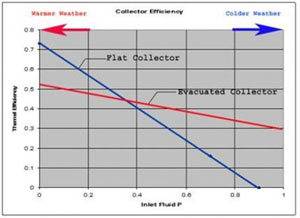This is the fourth in a series of posts written by Free Hot Water’s co-founder and senior mechanical engineer, Gal Moyal. We’ll be posting this series every Wednesday, so please make it a date. Some of the information may be very technical, but if you have any questions at all, please feel free to contact us. We sincerely want to help. If you would like to have a more hands-on experience, explore our certified Free Hot Water training courses. –Solar Fred.
Collector Efficiency
Now that we’re more familiar with the two main heat collection methods available, one may ask how we decide when to use one over the other? The answer is collector efficiency.
The first step in designing active solar thermal energy systems is to pick a system that will maximize energy extraction over a wide range of operating conditions.
One method is to compute the thermal efficiency of a collector, which is the ratio of the average heat output from the collector divided by the rate that solar radiation strikes the panel.
The thermal efficiency of a collector is calculated by using the formula bellow:
P= [(Ti – Ta) / I]
P= Inlet Fluid Parameter
Ti= Inlet fluid temperature to the collector (ºF)
Ta = Ambient air temperature surrounding the collector (ºF)
I = solar radiation intensity striking the collector (Btu/hr/ft2).
For the value of I (insolation) factor, look up the insolation table (Nasa Surface meteorology and Solar Energy Data Set)
The greater the delta value in fluid temperature of the inlet fluid Vs ambient, the harder the collector needs to “work.”
For example, a flat collector that has the efficiency characteristics of above line that receives water that has temperature of 55° F and the ambient temperature is 75° F with a radiation intensity of 110 Btu/Hr/Sqft (see above NASA link for your respective area) would compute as follow:
P=[(55-75)/110] = 0.18
Looking up 0.18 at the above graph would show that a flat collector would work best for that kind of environment.





















